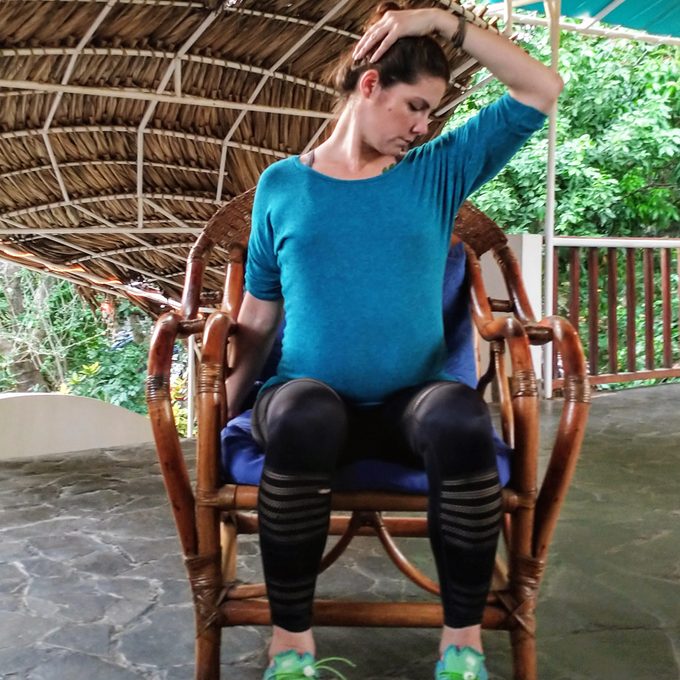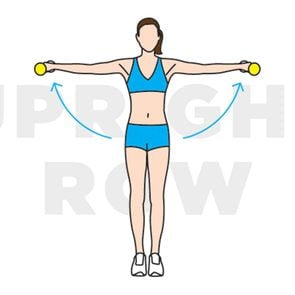Got a Tight Neck? Here’s How to Do a Levator Scapulae Stretch
Updated: Mar. 14, 2022
If you're constantly dealing with stress headaches, a tight levator scapulae might be to blame. Learn how to loosen it up to alleviate neck pain.
Dealing with a tight neck
Shrug your shoulders for a second—notice how your shoulder blades lift upward, allowing you to do the motion? Congratulations, you’ve just seen the levator scapulae at work.
As the name suggests, this small muscle group that connects the spine to the scapula is charged with elevating the scapula, as well as assisting larger muscle groups with other shoulder and neck motions. In other words, it’s a small muscle with an important job.
Now think for a second about what happens when you’re chronically stressed out, sitting at a desk all day, hunching forward in front of your computer.
Chances are, you’re crunching your shoulders up slightly, tightening the levator scapulae.
“Of all the muscles in the body, the levator scapulae is one of the most prone to becoming stiff,” says Brett Durney, co-founder and personal trainer at Fitness Lab, which operates boutique personal training gyms in London.
“A big part of this is the poor posture that many of us find ourselves in for large portions of the day—carrying heavy shoulder bags, hunching over a desk, holding a phone between the ear and the shoulder, and sleeping without proper support. Plus, high stress levels can also cause us to unwittingly scrunch up our shoulders,” Durney says.
(Here’s how to get quick stress relief.)
When neck pain might be your levator scapulae
As a result, if your levator scapulae is chronically engaged and tight, you’re likely to find yourself battling shoulder and neck pain (including shoulder impingement), as well as headaches at the back of the head and neck. You know—those nagging headaches that leave you massaging the base of your skull, praying they would go away.
(Learn how to get rid of your headaches.)
You may also find it harder to turn your head, lift your arms overhead, or put your chin on your chest.
Each of these movements requires the engagement of your levator scapulae, and if one (or both) of yours are tight, it’s going to be a whole lot harder to manage these basic movements.
This is exactly why stretching your levator scapulae on a regular basis is so important for shoulder and neck health.
“The levator scapulae should be a priority for stretching to prevent pain, stiffness, tightness, and impaired posture,” says Lisa N. Folden, a licensed physical therapist who runs Healthy Phit Physical Therapy and Wellness Consultants in Charlotte, North Carolina.
“But also to allow balance with other muscles of the neck, shoulder, and upper back. Achieving muscle balance is key for preventing long-term or chronic pain issues, specifically in the spine,” she says.
As Folden points out, if one muscle gets “out of whack,” it’s only a matter of time before surrounding musculature becomes involved and more problems arise.
(Try these neck exercises for pain relief.)
Stretching the levator scapulae
The thing is, the levator scapulae is a small muscle group that’s harder to “hit” with general upper body stretches. For this reason, you have to be more intentional about choosing stretches that isolate and target this muscle.
Both Folden and Durney point to the same stretch—the “armpit stretch”—for getting the job done.
It’s a simple stretch you can perform while at your desk at work or while relaxing at home. Or, of course, you can include it in your typical post-workout static stretch routine. (Learn the difference between static and dynamic stretching.)
Just remember, you’re doing a stretch that involves your neck and shoulder, so move slowly and gently and respect your body’s limits.
If you feel any pain, or the stretch feels uncomfortable (beyond what you’d expect from a gentle stretch), stop the exercise.
It’s always better to consult a doctor or physical therapist about pain to get a specific diagnosis than to force a movement or stretch in a way that could cause more problems.

The “armpit stretch” for the levator scapulae
Sit tall in a sturdy chair, your feet roughly hip-distance apart, planted on the ground.
Roll your shoulders back slightly, engage your core, and check your posture—your ears should be “stacked” over your shoulders and hips. You want your spine to feel upright and lengthened, as though you’re creating space between your vertebrae.
Reach your right hand behind you and lightly grasp the edge of your chair behind your hips.
Turn your head to the left and tilt your chin down toward your left shoulder, looking toward your left armpit.
Depending on how tight your levator scapulae is, you might already feel a stretch at the back of your neck and into your shoulder blade on your right side.
Reach your left hand up and place it lightly on the top of your head. Use your hand to gently “encourage” your head further downward toward your armpit to deepen the stretch.
Remember, you’re not forcing this movement and you’re looking for a gentle stretch, not something that will cause further pain.
When you reach the end of your range of motion, if you can, try using your right hand to pull lightly on the edge of your chair to help “add space” between your right shoulder and ear.
Find a comfortable stretch and hold the position for 20 to 30 seconds.
Release the stretch and repeat two more times before switching sides.
(Use these stretches to fix rounded shoulders.)
Don’t forget to treat the root cause
You can perform this stretch two to three times a day to help offer relief from any symptoms and to loosen up your levator scapulae over time.
That said, Durney points out that if you’re not addressing the root cause of the muscle tightness, you’re ultimately just chasing the problem.
“If you don’t change your habits and posture, then the tightness will simply return,” he says. “As an absolute priority, anyone suffering from tightness should work on fixing forward head posture.”
Talk to a physical therapist if you’re dealing with pain that’s interfering with daily life, and make sure that your exercise routine includes exercises like chin tucks and thoracic mobilization.
Even simple exercises, like a cat-cow stretch can make a difference over time.
Next, try these 5 neck stretches that can help alleviate neck pain.






















